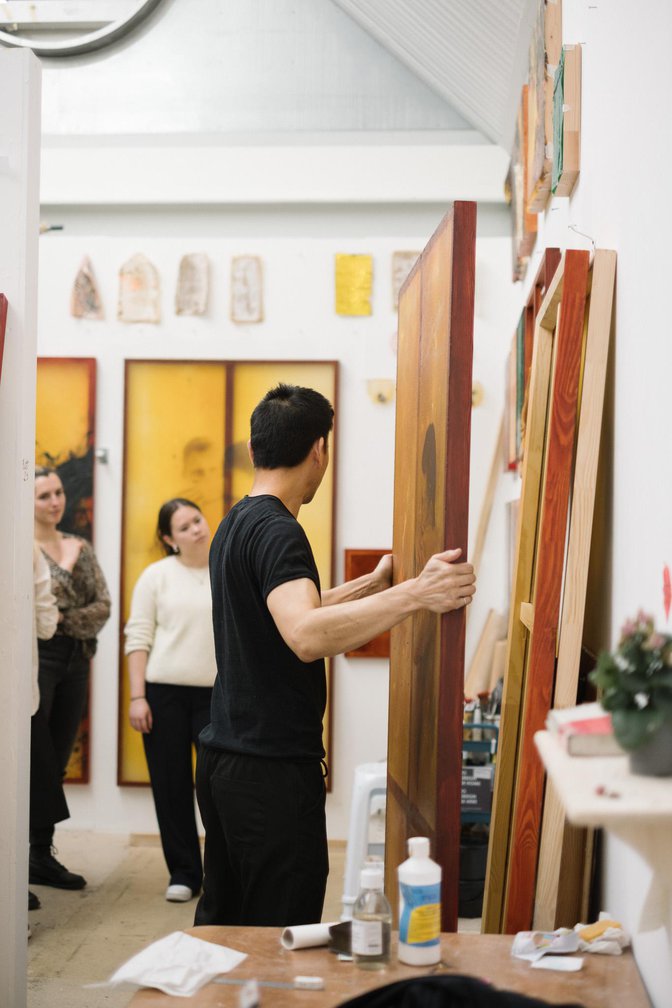article In conversation with
KV Duong
In conversation with
KV Duong
KV Duong

In conversation with KV Duong about
using your strengths and remaining
true to your artistry.
using your strengths and remaining
true to your artistry.
In conversation with KV Duong about
using your strengths and remaining
true to your artistry.
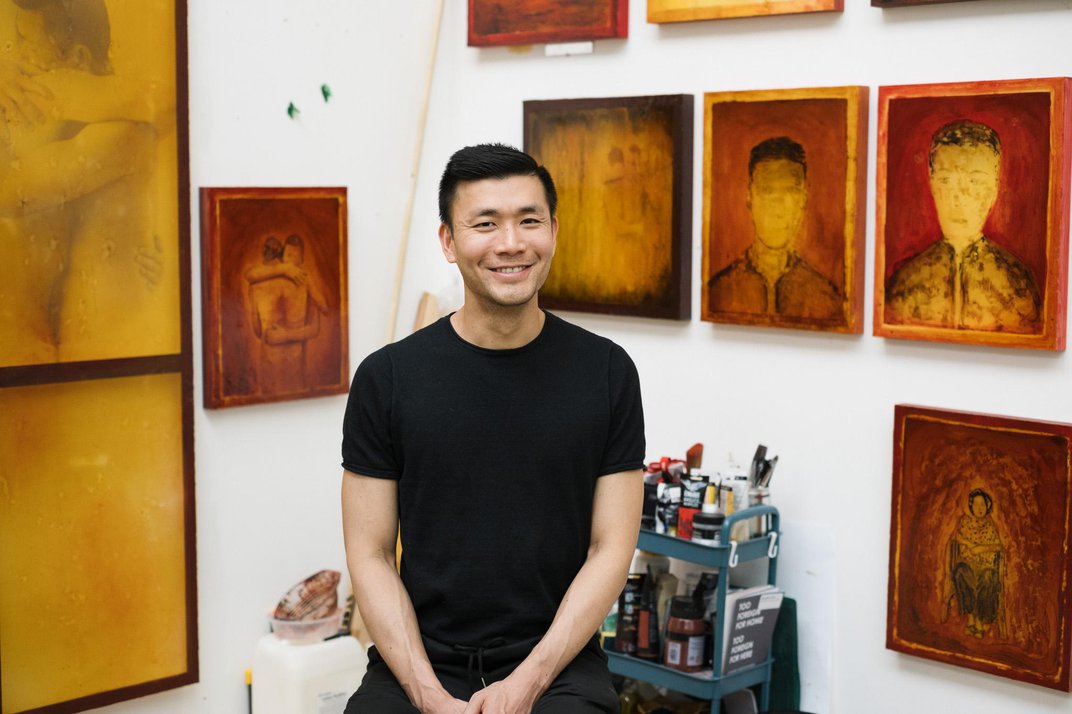
KV Duong is a Canadian-raised, Vietnamese artist living and working in London. Exploring the Vietnamese queer identity, his experimental approach to materiality creates personal, imagined landscapes that explore themes of migration, cultural assimilation, and personal history. He holds a Master’s in Structural Engineering from the University of Toronto and an MA in Painting from the Royal College of Art.

Artiq What inspired your career transition from engineering to art? How does this transition affect your making process?
KV I’ve always enjoyed making and viewing art since I was young. However, growing up in an immigrant household, pursuing art as a career wasn't an option. While my parents are aware of my 'art side hustle,' they don't know that I've taken a sabbatical from my structural engineering job to pursue an MA in Painting at the Royal College this year.
Transitioning careers comes with its challenges and advantages. Time, or the lack thereof, is the biggest challenge when balancing full-time work with an art career. However, the advantage is that I’m not yet dependent on art to make a living, which allows my output to be driven by my intuition rather than being influenced by commercial factors. I really want to create work that challenges viewers and provokes their thoughts on how we view the world.
Artiq You make use of various materials in your artworks, such as latex, fabric, and rice paper. How do these different materials influence your approach to a new piece?
KV I don’t know if my fascination with materials is intrinsic or developed through my engineering training, but I’m definitely drawn to trying out new materials, particularly industrial-type materials with textured and rough aesthetics. Specifically with latex, it’s such a slippery material to paint on, which forced me to relearn painting techniques from scratch. This process felt like a fresh start, rejuvenating my practice and leading to a new way of making and thinking.
During my MA studies, I chose to explore latex because of its historical connection to French colonial rubber plantations in Vietnam, while simultaneously referencing its sensuality and symbolic association with the queer experience.
KV I’ve always enjoyed making and viewing art since I was young. However, growing up in an immigrant household, pursuing art as a career wasn't an option. While my parents are aware of my 'art side hustle,' they don't know that I've taken a sabbatical from my structural engineering job to pursue an MA in Painting at the Royal College this year.
Transitioning careers comes with its challenges and advantages. Time, or the lack thereof, is the biggest challenge when balancing full-time work with an art career. However, the advantage is that I’m not yet dependent on art to make a living, which allows my output to be driven by my intuition rather than being influenced by commercial factors. I really want to create work that challenges viewers and provokes their thoughts on how we view the world.
Artiq You make use of various materials in your artworks, such as latex, fabric, and rice paper. How do these different materials influence your approach to a new piece?
KV I don’t know if my fascination with materials is intrinsic or developed through my engineering training, but I’m definitely drawn to trying out new materials, particularly industrial-type materials with textured and rough aesthetics. Specifically with latex, it’s such a slippery material to paint on, which forced me to relearn painting techniques from scratch. This process felt like a fresh start, rejuvenating my practice and leading to a new way of making and thinking.
During my MA studies, I chose to explore latex because of its historical connection to French colonial rubber plantations in Vietnam, while simultaneously referencing its sensuality and symbolic association with the queer experience.
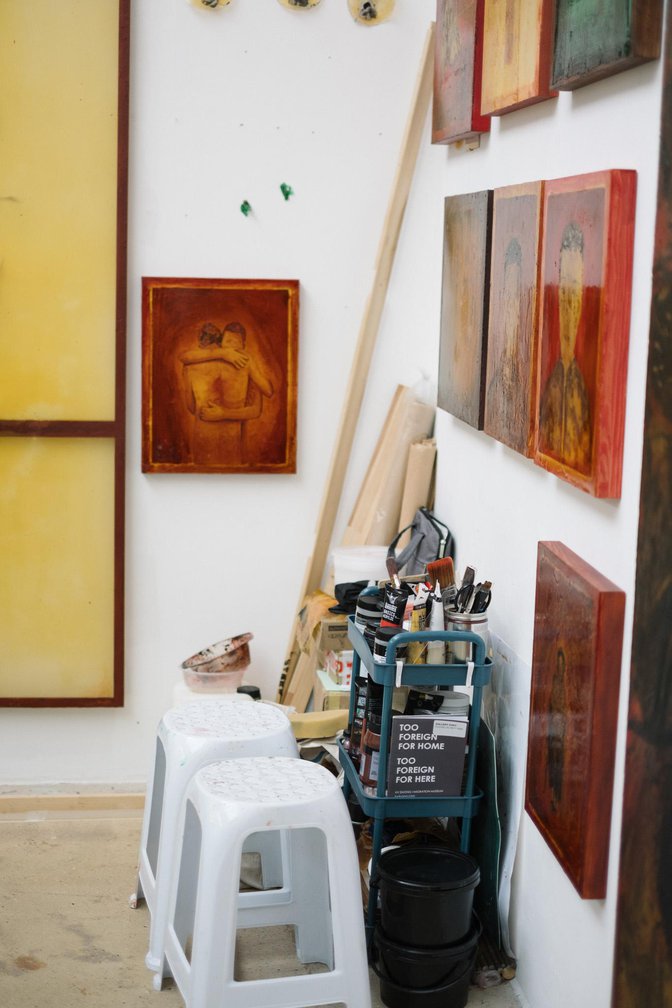
Artiq Could you please tell us more about how ‘texture’, especially of latex and paint, play a role in your work?
KV Stretched latex provides a unique painting surface. It’s slippery like a piece of glass yet possesses some absorbency like paper. Acrylic paint washes dry in a distinct way on this surface, a quality difficult to replicate elsewhere. Its soft, stretchy nature allows it to capture the dynamic movement of my body when I use my body as a painting brush, highlighting variations in pressure points and paint densities.
Working with different materials involves learning to utilize their strengths rather than forcing them against their nature. Allowing light through the latex is crucial; overworking or covering the surface can diminish its luminosity.
Artiq Your most recent pieces appear to be door-like and life-sized. You speak about how doors represent accessibility and inaccessibility. Could you please elaborate on this notion?
KV I've been using a motif of doors or portals to represent access and inaccessibility. When present, the crossbars, in relation to the transparency of latex, create divisions between interior and exterior spaces. My aim is to critique power dynamics in relation to our colonial past, LGBTQ+ history, and to question the nation as both a structure and a place where identity is shaped.
KV Stretched latex provides a unique painting surface. It’s slippery like a piece of glass yet possesses some absorbency like paper. Acrylic paint washes dry in a distinct way on this surface, a quality difficult to replicate elsewhere. Its soft, stretchy nature allows it to capture the dynamic movement of my body when I use my body as a painting brush, highlighting variations in pressure points and paint densities.
Working with different materials involves learning to utilize their strengths rather than forcing them against their nature. Allowing light through the latex is crucial; overworking or covering the surface can diminish its luminosity.
Artiq Your most recent pieces appear to be door-like and life-sized. You speak about how doors represent accessibility and inaccessibility. Could you please elaborate on this notion?
KV I've been using a motif of doors or portals to represent access and inaccessibility. When present, the crossbars, in relation to the transparency of latex, create divisions between interior and exterior spaces. My aim is to critique power dynamics in relation to our colonial past, LGBTQ+ history, and to question the nation as both a structure and a place where identity is shaped.
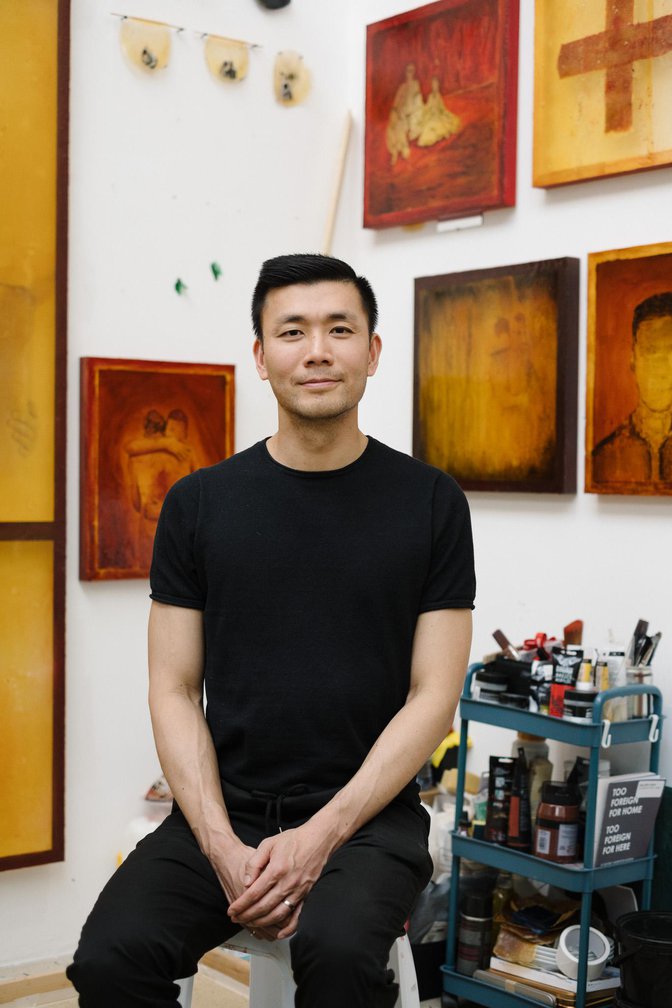
Artiq How have your artworks helped you to connect with your ancestral past?
KV Being an artist has allowed me time and access to inquire about my family history. I’ve asked my parents and aunts about their experiences of growing up in Vietnam, living through the war, and our extended family's journey as boat refugees in the early 1980s.
Beyond my family’s oral history, my research has led me to explore Vietnam's colonial past, including the periods ruled by China and France, and how this has influenced the modern-day city structure and language of Vietnam. Residing in London for the past 14 years, I have also delved into the history of Vietnamese migration in the UK and how the population has settled in, now, vibrant parts of Hackney, Deptford, and Lewisham.
Beyond the Vietnamese-specific references, my research has extended to encompass the lived experiences of the wider East and Southeast Asian diasporic community in London, exploring both the distinctive cultural experiences of our nationality and the common experiences that unite us.
Artiq Can you tell us about any projects you have coming up?
KV I’m gearing up for our Royal College of Art MA in Painting Public Exhibition (our Degree Show), slated for June and open to the public from the 20th to the 23rd.
In July, I have two exhibitions lined up. Firstly, I'll be showing at the University of Greenwich, Stephen Lawrence Gallery, in a group show centered around the theme of ‘Time, Space, Empire,’ alongside a stellar lineup of artists. Additionally, I'll be debuting some recent latex pieces at Chilli Art Projects' new gallery space in London.
Following that, "No Place Like Home: The Diaspora," a group exhibition hosted in St. Paul, Minneapolis, is set for this autumn. It will feature four UK-based artists paired with four local artists. This follows on from an exhibition I co-curated at the Museum of The Home last spring.
KV Being an artist has allowed me time and access to inquire about my family history. I’ve asked my parents and aunts about their experiences of growing up in Vietnam, living through the war, and our extended family's journey as boat refugees in the early 1980s.
Beyond my family’s oral history, my research has led me to explore Vietnam's colonial past, including the periods ruled by China and France, and how this has influenced the modern-day city structure and language of Vietnam. Residing in London for the past 14 years, I have also delved into the history of Vietnamese migration in the UK and how the population has settled in, now, vibrant parts of Hackney, Deptford, and Lewisham.
Beyond the Vietnamese-specific references, my research has extended to encompass the lived experiences of the wider East and Southeast Asian diasporic community in London, exploring both the distinctive cultural experiences of our nationality and the common experiences that unite us.
Artiq Can you tell us about any projects you have coming up?
KV I’m gearing up for our Royal College of Art MA in Painting Public Exhibition (our Degree Show), slated for June and open to the public from the 20th to the 23rd.
In July, I have two exhibitions lined up. Firstly, I'll be showing at the University of Greenwich, Stephen Lawrence Gallery, in a group show centered around the theme of ‘Time, Space, Empire,’ alongside a stellar lineup of artists. Additionally, I'll be debuting some recent latex pieces at Chilli Art Projects' new gallery space in London.
Following that, "No Place Like Home: The Diaspora," a group exhibition hosted in St. Paul, Minneapolis, is set for this autumn. It will feature four UK-based artists paired with four local artists. This follows on from an exhibition I co-curated at the Museum of The Home last spring.
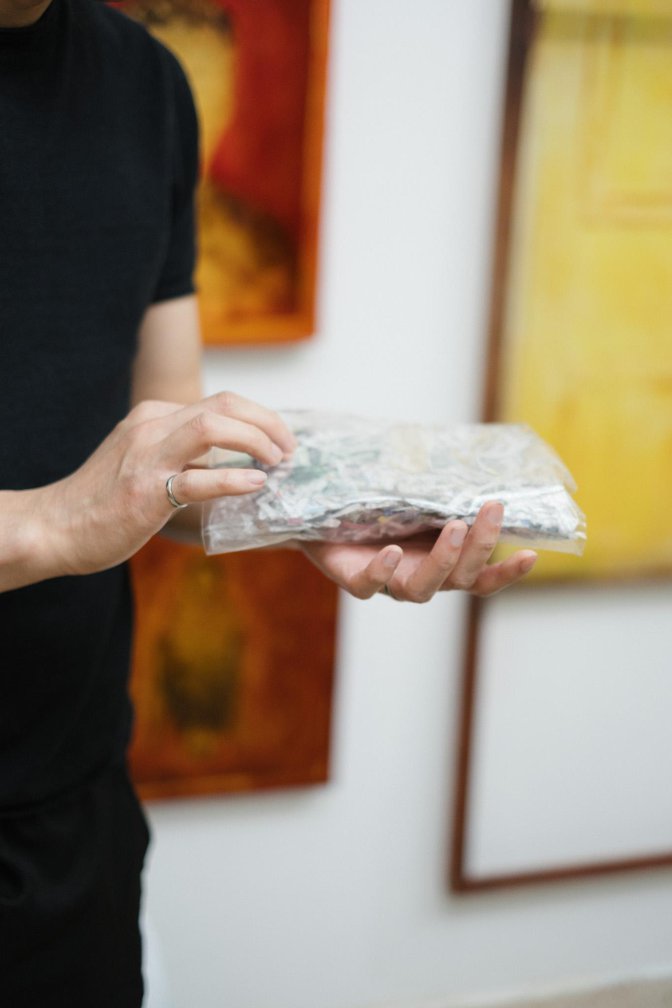
Artiq Your work focuses on the idea of identity formation. How does your transnational background influence your creative practice?
KV Arriving in Canada with my family at age seven, we settled in Toronto's Vietnamese-Chinese community where I adapted well despite initial culture shock. It wasn’t until adulthood, traveling abroad to Europe, that I faced scrutiny for my appearance and origin because I didn’t meet the expectations of what a Canadian person may look like. This realization of being perceived as "the other" expanded my worldview and fostered a commitment to understanding diverse perspectives, particularly amidst escalating cultural tensions worldwide. As a queer person, I've often felt like an outsider, shaping my awareness of social and political landscapes.
These experiences deeply influence my art, which delves into themes of assimilation, free speech, border control, and cultural conflict. Reflecting on the complexities of diasporic life in a predominantly white society, I frequently ponder the concept of home.
KV Arriving in Canada with my family at age seven, we settled in Toronto's Vietnamese-Chinese community where I adapted well despite initial culture shock. It wasn’t until adulthood, traveling abroad to Europe, that I faced scrutiny for my appearance and origin because I didn’t meet the expectations of what a Canadian person may look like. This realization of being perceived as "the other" expanded my worldview and fostered a commitment to understanding diverse perspectives, particularly amidst escalating cultural tensions worldwide. As a queer person, I've often felt like an outsider, shaping my awareness of social and political landscapes.
These experiences deeply influence my art, which delves into themes of assimilation, free speech, border control, and cultural conflict. Reflecting on the complexities of diasporic life in a predominantly white society, I frequently ponder the concept of home.
